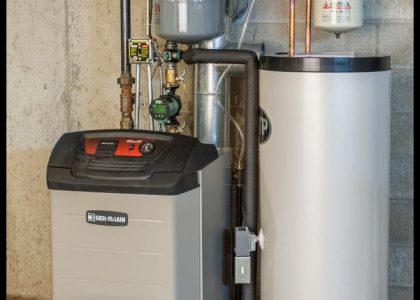Trade Journals are currently publishing the Annual Boiler Report for 2019. It is lengthy, detailed and provides tradesmen insight into both Industry Development and Regulatory Trends. Content and commentary is typically provided by Sales, Marketing and Product Managers of the various Boiler Manufacturers.
Of particular note is the trend toward larger, commercial grade condensing gas systems and focus on advanced fire-tube heat exchanger designs. These new products are also being highly sensor-instrumented with interface optioning to IoT and Building Energy Management Systems. Further, industry focus appears to be upon gas-fired market development with no direct mention of oil throughout. However the inferences within the specific participant content need extraction and commentary.
Industry Regulation of the Boiler Industry via DOE AFUE Requirements both current and projected are significant, well defined and discussed. Again the focus is wholly upon the Gas Appliance Market and the incremental impacts between 2020 and 2023, as interpreted. DOE has yet to become specific on Commercial Boiler AFUE’s and implementation points, but “residential gas boilers must have an AFUE of 90 percent or greater in all applications”. The new boiler efficiency standard will become effective in 2021.
In this new world there will be effectively little gas-fired cast-iron in particular and with predictable consequence. This point is well reinforced in the report by comment of a major boiler manufacturer that “many customers are still looking for the long-term dependability of cast iron. When you really factor in everything from the cost of the boiler, installation cost, maintenance costs and life expectancies, cast iron is still a very sound choice”. Weil-McLain also weighs in: “Our legacy cast-iron lines have set the standard for performance and longevity with our high-efficiency lines continuing to lead the industry in innovation, operating fuel efficiency and ease of installation and maintenance”. Are we “throwing out the baby with the bath water”, to employ the old adage? The effect is to supplant in our view with a potentially less durable, but more sophisticated and costlier product. The marketplace will ultimately decide.
“Products that can connect to a smart device and be monitored remotely is a heightened demand in the heating industry.” This is self-evident in the commercial sector and upscale housing where loss prevention can be outweighed by the added technology costs. In our personal experience the Wi-Fi Thermostat has widely infiltrated our residential consumer base. Witness a mid-winter night call from a customer in Pearl Harbor, Hawaii that his N.H. ski cottage had a temperature drop issue ….. using his cell phone and Wi-Fi Thermostat. To another we provided our oil boiler system with temperature sensor provisions to winter freeze-inhibit his outdoor wood boiler while he annually holidayed with family in the south. Consumers are becoming a savvy bunch and consequentially arrive at cost-effective system application solutions. This is well reinforced by a Boiler Report commentary that “adoption of new technology takes longer in the heating industry than in many other industries” ….. excepting “cool” customers?
Technological boiler design inception is being tempered by the critical shortage of skilled trade personnel. “A large population of contractors are starting to reach retirement age and a much younger group is starting to enter the field.” Integrating gas boiler system elements such as hydronic expansion, circulation (internal and external), zone and system controls into their products is widespread in reducing installed costs and installation times. A major manufacturer states “we have opted to exponentially increase the number of training events both here at our facility and at locations throughout the country”. Our personal 60-plus year observation: residential heating installers in particular have never kept up with industry technology and it promises to not get better ….. technology far outpaces its proper application in the trades.
Interwoven in the Boiler Report is commentary on “ours vs. theirs” offerings by boiler types, and most specifically the gas “Combi-Boilers” and their limitations. “One of the major drawbacks of a combination boiler is that you can only use one of the functions at a time, which can cause potentially uncomfortable situation for a homeowner.” This provider further advises of his “revolutionary design that allows for true simultaneous domestic and heating functionality”. This and other discussion support our field observation that misapplication of boiler designs to applications is evident in both gas and oil heating. Contemporary residential distribution piping practices in particular emphasize aesthetics vs. technical correctness. Witness the recent trade supplier “photo contests” to provide the prettiest workmanship installations. Nothing new ….. technology is misunderstood and hence misapplied.
A common boiler provider’s theme is “design-for-manufacture” as we manufacturing engineers refer to obtain “economies-of-scale”. “We have components prebuilt within the factory.” The particular comment of “parts standardization across all manufacturer lines” may aid the individual boiler supplier, but there are very few common sensory and control parts in the emerging condensing gas industry in total. A Gas Heating Serviceman in a rural area (typically LP-Propane) cannot possibly stock nor have ready Trade Distributor access to boiler manufacturer-specific service parts. The customer is too often left cold ….. and angry! In fact it is difficult to find propane service by other than a Factory Technician, if that is even available. In the maturation process, the industry as a whole must address technical standardization and service issues ….. or stall.
Underlying all these points noted from The 2019 Boiler Report is a more profound one ….. addressing the entire hydronic system installation methodology from a total system efficiency perspective. Other than providing a “Boiler Installation Guide” with generic piping and wiring installation diagrams therein, the residential heating industry ignores aggregate system efficiencies. The boiler (heating) industry sells components ….. not systems. The integration of distribution and control elements into new condensing gas offerings is commendable, yet a small beginning. Emergence of efficiency-optimized boiler/distribution gas or oil heating appliances at minimum are required. The system elements are there, but their evolution into particularly residential heating appliances will be painfully and historically slow …..

